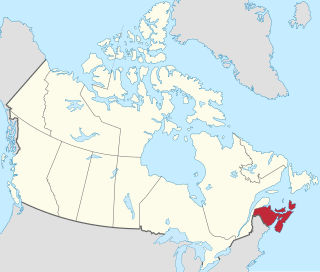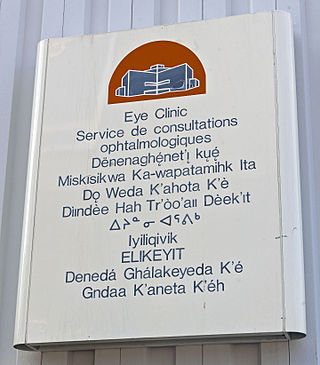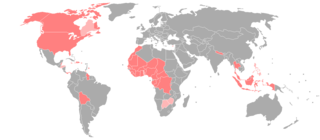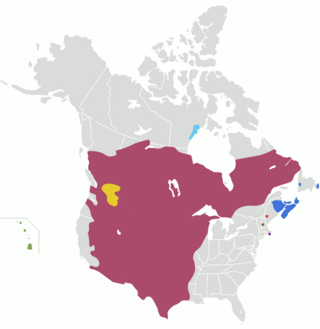
American Sign Language (ASL) is a natural language that serves as the predominant sign language of Deaf communities in the United States and most of Anglophone Canada. ASL is a complete and organized visual language that is expressed by employing both manual and nonmanual features. Besides North America, dialects of ASL and ASL-based creoles are used in many countries around the world, including much of West Africa and parts of Southeast Asia. ASL is also widely learned as a second language, serving as a lingua franca. ASL is most closely related to French Sign Language (LSF). It has been proposed that ASL is a creole language of LSF, although ASL shows features atypical of creole languages, such as agglutinative morphology.

The Maritimes, also called the Maritime provinces, is a region of Eastern Canada consisting of three provinces: New Brunswick, Nova Scotia, and Prince Edward Island. The Maritimes had a population of 1,899,324 in 2021, which makes up 5.1% of Canada's population. Together with Canada's easternmost province, Newfoundland and Labrador, the Maritime provinces make up the region of Atlantic Canada.

Fingerspelling is the representation of the letters of a writing system, and sometimes numeral systems, using only the hands. These manual alphabets have often been used in deaf education and have subsequently been adopted as a distinct part of a number of sign languages. There are about forty manual alphabets around the world. Historically, manual alphabets have had a number of additional applications—including use as ciphers, as mnemonics and in silent religious settings.

Sign languages are languages that use the visual-manual modality to convey meaning, instead of spoken words. Sign languages are expressed through manual articulation in combination with non-manual markers. Sign languages are full-fledged natural languages with their own grammar and lexicon. Sign languages are not universal and are usually not mutually intelligible, although there are similarities among different sign languages.

A multitude of languages have always been spoken in Canada. Prior to Confederation, the territories that would become Canada were home to over 70 distinct languages across 12 or so language families. Today, a majority of those indigenous languages are still spoken; however, most are endangered and only about 0.6% of the Canadian population report an Indigenous language as their mother tongue. Since the establishment of the Canadian state, English and French have been the co-official languages and are, by far, the most-spoken languages in the country.
The American Manual Alphabet (AMA) is a manual alphabet that augments the vocabulary of American Sign Language.
Hawaiʻi Sign Language or Hawaiian Sign Language, also known as Hoailona ʻŌlelo, Old Hawaiʻi Sign Language and Hawaiʻi Pidgin Sign Language, is an indigenous sign language native to Hawaiʻi. Historical records document its presence on the islands as early as the 1820s, but HSL was not formally recognized by linguists until 2013.

Maritime Union is a proposed political union of the three Maritime provinces of Canada – New Brunswick, Nova Scotia, and Prince Edward Island – to form a single new province.
Manually Coded English (MCE) is an umbrella term referring to a number of invented manual codes intended to visually represent the exact grammar and morphology of spoken English. Different codes of MCE vary in the levels of adherence to spoken English grammar, morphology, and syntax. MCE is typically used in conjunction with direct spoken English.
A contact sign language, or contact sign, is a variety or style of language that arises from contact between deaf individuals using a sign language and hearing individuals using an oral language. Contact languages also arise between different sign languages, although the term pidgin rather than contact sign is used to describe such phenomena.
Manually coded languages (MCLs) are a family of gestural communication methods which include gestural spelling as well as constructed languages which directly interpolate the grammar and syntax of oral languages in a gestural-visual form—that is, signed versions of oral languages. Unlike the sign languages that have evolved naturally in deaf communities, these manual codes are the conscious invention of deaf and hearing educators, and as such lack the distinct spatial structures present in native deaf sign languages. MCLs mostly follow the grammar of the oral language—or, more precisely, of the written form of the oral language that they interpolate. They have been mainly used in deaf education in an effort to "represent English on the hands" and by sign language interpreters in K-12 schools, although they have had some influence on deaf sign languages where their implementation was widespread.

Atlantic Canadian English is a class of Canadian English dialects spoken in Atlantic Canada that is notably distinct from Standard Canadian English. It is composed of Maritime English and Newfoundland English. It was mostly influenced by British and Irish English, Irish and Scottish Gaelic, and some Acadian French. Atlantic Canada is the easternmost region of Canada, comprising four provinces located on the Atlantic coast: Newfoundland and Labrador, plus the three Maritime provinces of Nova Scotia, New Brunswick, and Prince Edward Island. Regions such as Miramichi and Cape Breton have a wide variety of phrases and words not spoken outside of their respective regions.
Chinese Sign Language is the main sign language used in China. It is not related to the Taiwanese Sign Language used in Taiwan. Manually coded Mandarin is referred to as Wénfǎ Shǒuyǔ.
Guatemalan Sign Language or Lensegua is the proposed national deaf sign language of Guatemala, formerly equated by most users and most literature equates with the sign language known by the acronymic abbreviations LENSEGUA, Lensegua, and LenSeGua. Recent legal initiatives have sought to define the term more inclusively, so that it encompasses all the distinctive sign languages and sign systems native to the country.
The deaf sign language of the nations of the former Yugoslavia, known variously as Croatian Sign Language, Kosovar Sign Language, Serbian Sign Language, Bosnian Sign Language, Macedonian Sign Language, Slovenian Sign Language, or Yugoslav Sign Language (YSL), started off when children were sent to schools for the deaf in Austro-Hungary in the early 19th century. The first two local schools opened in 1840 in Slovenia and in 1885 in Croatia.
Inuit Sign Language is one of the Inuit languages and the indigenous sign language of the Inuit people. It is a language isolate native to Inuit communities in the Canadian Arctic. It is currently only attested within certain communities in Nunavut, particularly Baker Lake and Rankin Inlet. Although there is a possibility that it may be used in other places where Inuit live in the Arctic, this has not been confirmed.
Ugandan Sign Language (USL) is the deaf sign language of Uganda.

The Halifax School for the Deaf was an institution in Halifax, Nova Scotia, Canada, which opened on 4 August 1856. It was the first school of the deaf in Atlantic Canada. There was later a dispute over who the true founder was, William Gray (1806-1881), a deaf Scottish immigrant who was the first teacher in the back room of a house in Argyle Street, or George Tait (1828-1904), another deaf Scot, who claimed to have been the driving force behind the establishment of the school. Gray was sacked in 1870 for being intoxicated and for threatening pupils with violence.

James Scott Hutton was the first principal of the Halifax School for the Deaf, and remained with the school for 34 years until his death in 1891. The Halifax School for the Deaf was the first school of the deaf in Atlantic Canada (1856). Along with teaching sign language, Hutton followed the lead of fellow Nova Scotian and advocate for the deaf Alexander Graham Bell by integrating lip-reading into the curriculum. From 1878 to 1882 he served as principal of a similar institution in Belfast.

American Sign Language (ASL) developed in the United States, starting as a blend of local sign languages and French Sign Language (FSL). Local varieties have developed in many countries, but there is little research on which should be considered dialects of ASL and which have diverged to the point of being distinct languages.










